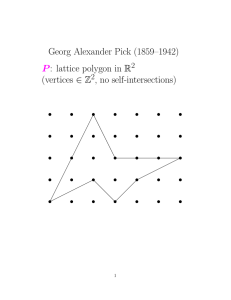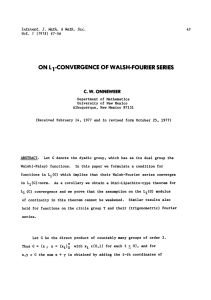DEF. unimodal log-concave no internal zeros
advertisement
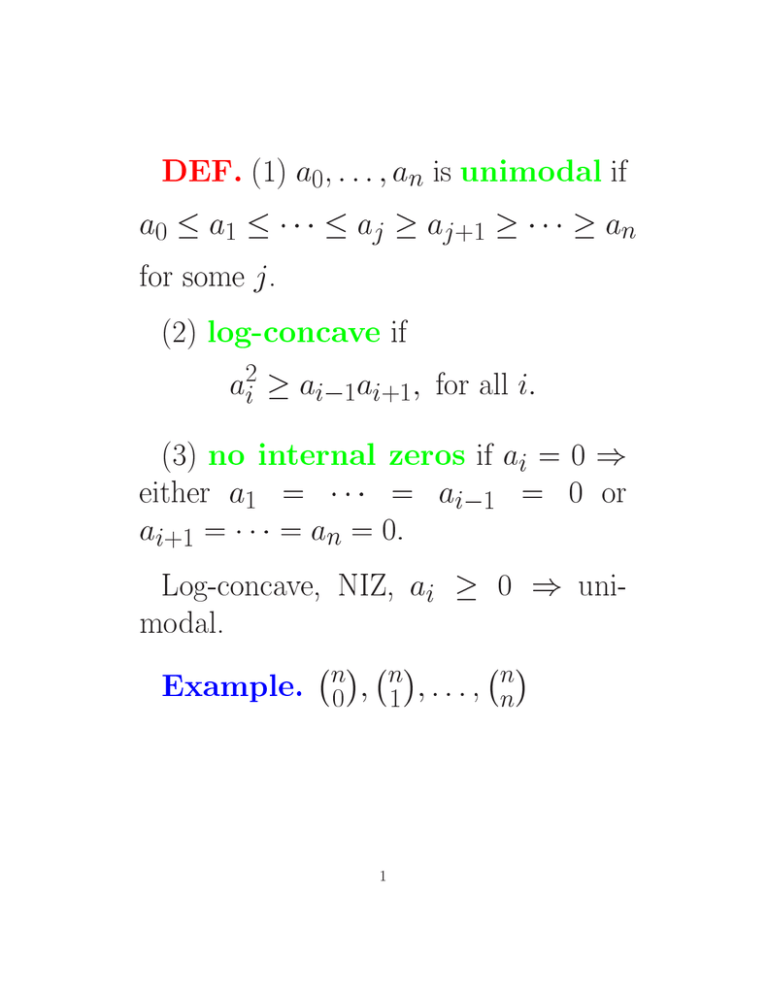
DEF. (1) a ; : : : ; an is unimodal if
a a aj aj an
0
0
1
for some j .
(2) log-concave if
+1
ai ai ai ; for all i:
2
1
+1
(3) no internal zeros if ai = 0 )
either a = = ai = 0 or
ai = = an = 0.
Log-concave, NIZ, ai 0 ) unimodal.
1
1
+1
Example.
n
0
n
;
1
1
;:::;
n
n
I. REAL ZEROS
Theorem (Newton). Let
; : : : ; n 2 R
1
and
P (x) =
Y
(x + i) =
X
n
ai i xi:
Then a ; a ; : : : ; an is log-concave.
Proof. P n i (x) has real zeros
) Q(x) := xi P n i (1=x) has real zeros
) Q i (x) has real zeros:
n
i
But Q (x) = ai + 2aix + ai x
0
1
(
1)
+1
(
(
(
1)
1)
!
1)
2
1
2
) ai ai ai : 2
2
1
2
+1
+1
Example.
Hermite polynomials:
Hn(x) =
bX
n= c
2
k =0
( 1)k n! (2x)n
k! (n 2k)!
2
k
2
d
Hn(x) = e dx e x Hn (x) :
By induction, Hn (x) has n 1 real
2
x
zeros. Since e Hn (x) ! 0 as x !
1, it follow that Hn(x) has n real zeros
interlaced by the zeros of Hn (x).
x2
1
1
1
1
3
400
200
4
-3
-2
-1
00
1
2
x
-200
-400
3
2.2
0
-10
5
-20
-30
-40
2.3
2.4
2.5
x
2.6
2.7
2.8
2.9
3
Example (Heilmann-Lieb, 1972). Let
G be a graph with ti i-sets of edges
with no vertex in P
common (matching
of size i). Then i tixi has only real
zeros.
Theorem (Aissen-Schoenberg-Whitney,
Pn
1952) The polynomial i aixi has
only real nonpositive zeros if and only
if every minor of the following matrix
is nonnegative:
3
2
a a a an 0 7
6 0 a a an
a
n
7
6
6 0 0 a an
an 77
6
=0
0
4
1
2
0
1
1
0
6
2
1
5
Let P be a nite poset with no induced 3 + 1. Let ci be the number of
i-element chains of P .
bad
Theorem.
ros.
c0 = 1
c1 = 5
c2 = 5
c3= 1
P
cixi has only real ze-
7
Conjecture (Neggers-S, c. 1970). Let
P be a (nite) distributive lattice (a
collection of sets closed under [ and
^0 and ^1
\, ordered by inclusion),
with
P
removed. Then cixi has only real
zeros.
abcd
abc
abd
ab
bc
a
b
φ
c0 = 1
c1 = 6
c2 = 10
c3 = 5
8
Example. If A is a (real) symmetric
matrix, then every zero of det(I + xA)
is real.
Corollary. Let G be a graph. Let
ai be the number of rootedPspanning
forests with i edges. Then aixi has
only real zeros.
Open for unrooted spanning forests.
9
II. ANALYTIC METHODS
Let p(n; k) be the number of partitions of n into k parts. E.g., p(7; 3) = 4:
5+1+1; 4+2+1; 3+3+1; 3+2+2:
k
x
p(n; k)x =
k)
(1
x
)(1
x
)
(1
x
n
I
k n ds
1
s
) p(n; k) = 2i (1 s)(1 s ) (1 sk ) :
X
n
2
0
1
2
10
Theorem (Szekeres, 1954) For n >
N , the sequence
p(n; 1); p(n; 2); : : : ; p(n; n)
0
is unimodal, with maximum at
p
3 3
1
k = c nL + c 2 + 2 L 4 L
!
log n
+O p
2
2
4
n
p
p
L = log c n:
c = 6=;
11
1
2
Theorem (Entringer, 1968). The poly-
nomial
(1 + q) (1 + q ) (1 + qn)
has unimodal coecients.
Theorem (Odlyzko-Richmond, 1980).
For \nice" a ; a ; : : :, the polynomial
(1 + qa1 ) (1 + qan )
has \almost" unimodal coecients.
2
1
2 2
2
12
2
III. ALEKSANDROV-FENCHEL
INEQUALITIES (1936{38)
Let K; L be convex bodies (nonempty
compact convex sets) in R n , and let
x; y 0. Dene the Minkowski sum
xK +yL = fx+y : 2 K; 2 Lg:
Then there exist Vi(K; L) 0, the (Minkowski) mixed volumes of K and
L, satisfying
n X
n
n i i
V
(
K;
L
)
x
y
:
i
i
i
Note V = Vol(K ), Vn = Vol(L).
Theorem. Vi Vi Vi
Vol(xK +yL) =
=0
0
2
1
13
+1
Corollary. Let P be an n-element
poset. Fix x 2 P . Let Ni denote the
number of order-preserving bijections
(linear extensions)
f : P ! f1; 2; : : : ; ng
such that f (x) = i. Then
Ni Ni Ni :
2
1
+1
Proof. Find K; L R n such that
Vi(K; L) = Ni . 2
1
+1
14
123 45
1235 4
12 4 35
21345
21354
214 35
2 4135
5
3
4
1
2
4
5
3
4
5
3
4
(N ; : : : ; N ) = (0; 1; 2; 2; 2)
1
5
15
Variation (Kahn-Saks, 1984). Fix
x < y in P . Let Mi be the number of
linear extensions f with f (y) f (x) =
i. Then Mi Mi Mi , i 1.
Corollary. If P isn't a chain, then
there exist x; y 2 P such that the
probability P (x < y) that x < y in
a linear extension of P satises
3
8
P
(x < y ) :
11
11
2
1
+1
Best bound to datep(Brightwell-Felsner5+ 5
(instead of 3/11)
Trotter, 1995):
10
Conjectured bound: 1/3
16
IV. REPRESENTATIONS OF
SL(2; C ) AND sl(2; C )
Let
G = SL(2; C ) = f2 2 complex
matrices with determinant 1g:
Let A 2 G, with eigenvalues ; .
For all n 0, there is a unique irre1
ducible (polynomial) representation
'n : G ! GL(Vn )
of dimension n+1, and 'n(A) has eigenvalues
+1
n; n+2
;
n+4
; : : : ; n:
Every representation is a direct sum of
irreducibles.
17
If ' : G ! GL(V ) is any (nitedimensional) representation, then
X
tr '(A) = aii; ai = a i
i2Z
X
= (ai ai ) i + i + + i
i
+2
2
0
) ai ai
) fa ig; fa i g are unimodal
2
2
2 +1
(and symmetric)
(Completely analogous construction for
the Lie algebra sl(2; C ).)
18
Example. S k ('n), eigenvalues
t1
t
n 0 n
( n ) t n ;
t + t + + tn = k
)
tr '(A) =
X
+2
0
t0+
+
1
t0
n)+t1( n+2)+
(
tn=k
tnn
n
+k
=
k 2
X
nk
=
Pi(n; k) i;
nk
+
2
where Pi(n; k) is the number of partitions of i with k parts, largest part
n.
i
0
19
) P (n; k); : : : ; Pnk (n; k)
is unimodal (Sylvester, 1878).
0
Combinatorial proof by K. O'Hara, 1990.
0
1
2
2
3
3
4
4
5
6
X
Pi(3; 2)qi =
i
1 + q + 2q + 2q + 2q + q + q
5 (1 q )(1 q )
=
=
2
(1 q )(1 q)
2
3
4
5
2
20
5
4
6
Superanalogue. Replace sl(2; C )
with the (ve-dimensional) Lie superalgebra osp(1; 2). One irreducible rep-
resentation 'n of each dimension 2n + 1.
If A 2 osp(1; 2) has eigenvalues
; ; 1; ; ;
then 'n has eigenvalues n; n ; : : : ; n.
Example. S k ('n) leads to unimodality of
Q (2n; k); Q (2n; k); : : : ; Q nk (2n; k);
where Qi(2n; k) is the number of partitions of i with largest part 2n, at
most k parts, and no repeated odd part.
2
1
2
+1
0
1
2
21
0
4
1
2
3
3
4
4
5
5
6
7
8
X
Qi(4; 2)qi =
i
1+q+2q +2q +3q +2q +2q +q +q
2
3
4
bosons
5
fermions
22
6
7
8
Example. Let g be a nite-dimensional
complex semisimple Lie algebra. Then
there exists a principal sl(2; C ) g.
A representation ' : g ! gl(V ) restricts to
' : sl(2; C ) ! gl(V ):
Example. g = so(2n + 1; C ), ' =
spin representation:
) (1 + q)(1 + q ) (1 + qn)
has unimodal coecients (Dynkin 1950,
Hughes 1977). (No combinatorial proof
known.)
2
23
Example. Let X be an irreducible
n-dimensional complex projective vari-
ety with nite quotient singularities (e.g.,
smooth).
i = dimC H i(X ; C )
sl(2; C ) acts on H (X ; C ), and H i(X ; C )
is a weight space with weight i N
) f ig; f i g are unimodal:
2
2 +1
24
Example. X = Gk(C n k ) (Grass+
mannian). Then
X
n
+k
:
i = k
2
i
Example. Let P be a simplicial poly-
tope, with fi i-dimensional faces (with
f = 0). E.g., for the octahedron,
f = 6; f = 12; f = 8:
Dene the h-vector (h ; h ; : : : ; hd) of
P by
1
0
1
2
0
d
X
fi (x 1)d i =
1
d
X
1
hixd i:
i=0
i=0
E.g., for the octahedron,
(x 1) +6(x 1) +12(x 1)+8 = x +3x +3x+1:
3
2
3
25
2
Dehn-Sommerville equations (1905,1927):
hi = hd
i
GLBC (McMullen-Walkup, 1971):
h h hbd= c
(Generalized Lower Bound Conjecture)
0
1
2
26
Let X (P ) be the toric variety corresponding to P . Then P is an irreducible
complex projective variety with nite
quotient singularities, and
2i
j (X (P )) = h0i;; ifif jj =is odd
:
) GLBC:
27
Hessenberg varieties. Fix 1 p n 1. For w = w wn 2 Sn,
1
let
dp(w) = #f(i; j ) : wi > wj ; 1 j i pg:
d (w) = #descents of w
dp (w) = #inversions of w:
1
1
Let
Ap(n; k) = #fw 2 Sn : dp(w) = kg:
Theorem (de Mari-Shayman, 1987).
The sequence
Ap(n; 0); Ap(n; 1); : : : ; Ap(n; p(2n p 1)=2)
is unimodal.
Proof. Construct a \generalized Hessenberg variety" Xnp satisfying k (Xnp) =
Ap(n; k). 2
2
28
V. REPRESENTATIONS OF FINITE
GROUPS
Let #S = n and G S(S ), the
group of all permutations of S . Let
G^ denote the set of all (ordinary) irreducible characters of G. Let S
i = character of G on i ;
S
where i = fT S : #T = ig.
Note: i = n i.
Write
i =
X
2
^
G
29
mi():
Theorem. For all 2 G^ , the se-
quence
m (); m (); : : : ; mn()
0
1
is symmetric and unimodal.
Proof. Let 0 i < n=
2. Dene
':C
by
S !C S
i+1
i
'(T ) =
X
T 0 T
#T 0=i+1
T 0:
Easy: ' commutes with the action of
G.
Not dicult: ' is injective (one-toone).
) i i : 2
+1
30
Corollary (Livingstone and Wagner,
1965). ( = 1) Let
S
fi = i /G ;
the number of orbits of G acting on
S
i . Then fi = fn i and f ; f ; : : : ; fn
is unimodal.
Corollary. Let Np(q) be the number of nonisomorphic graphs (without
loops or multiple edges) with p vertices and q edges. Then the sequence
Np(0); Np(1); : : : ; Np(p(p 1)=2)
is symmetric and unimodal.
0
31
1
(N (0); : : : ; N (6)) = (1; 1; 2; 3; 2; 1; 1)
4
4
32
Example. S = f1; : : : ; rgf1; : : : ; sg
G = Sr o Ss
hr + si
X
) fiqi = r q
33
REFERENCES (incomplete)
1. F. Brenti,
2. G. R. Brightwell, S. Felsner, and W. T. Trotter, Balancing
pairs and the cross product conjecture, Order 12 (1995),
327{349.
3. F. de Mari and M. A. Shayman,
4. E. B. Dynkin, Some properties of the weight system
5. Hughes,
6. J. Kahn and M. Saks, Balancing poset extensions, Order 1
(1984), 113{126.
7. D. Livingstone and A. Wagner, Transitivity of nite permutation groups on unordered sets, Math. Z. 90 (1965),
393{403.
8. K. M. O'Hara, Unimodality of Gaussian coecients: a constructive proof, J. Combinatorial Theory (A) 53 (1990),
29{52.
9. R. Stanley, The number of faces of a simplicial convex polytope, Advances in Math. 35 (1980), 236{238.
10. R. Stanley, Two combinatorial applications of the AleksandrovFenchel inequalities, J. Combinatorial Theory (A) 31 (1981),
56{65.
11. R. Stanley, Unimodality and Lie superalgebras, Studies in
Applied Math. 72 (1985), 263{281.
12. R. Stanley, Unimodal and log-concave sequences in algebra, combinatorics, and geometry, in Graph Theory and Its
Applications: East and West, Ann. New York Acad. Sci.,
vol. 576, 1989, pp. 500{535.
13. D. Zeilberger, Kathy O'Hara's constructive proof of the unimodality of the Gaussian polynomials, Amer. Math. Monthly
96 (1989), 590{602.
34




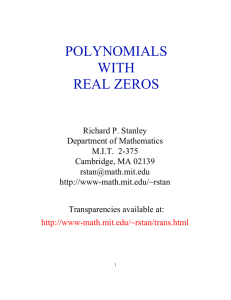
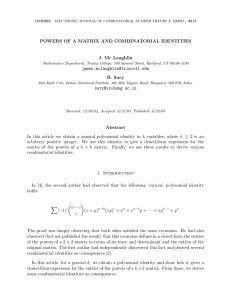

![5.5 The Haar basis is Unconditional in L [0, 1], 1 < 1](http://s2.studylib.net/store/data/010396305_1-450d5558097f626a0645448301e2bb4e-300x300.png)
